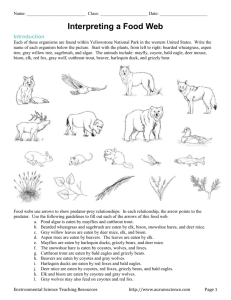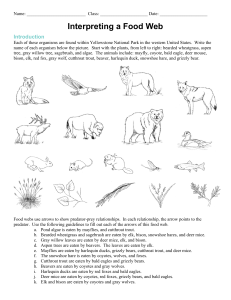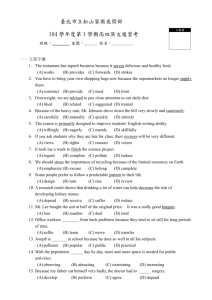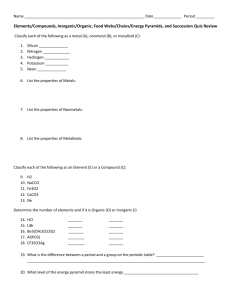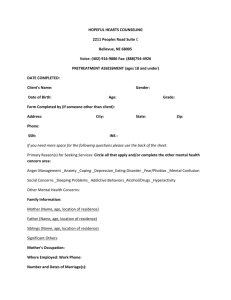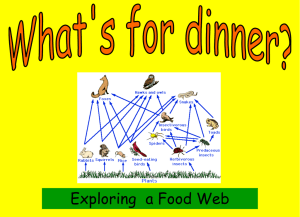Interpreting a Food Web Introduction Each of these organisms are
advertisement
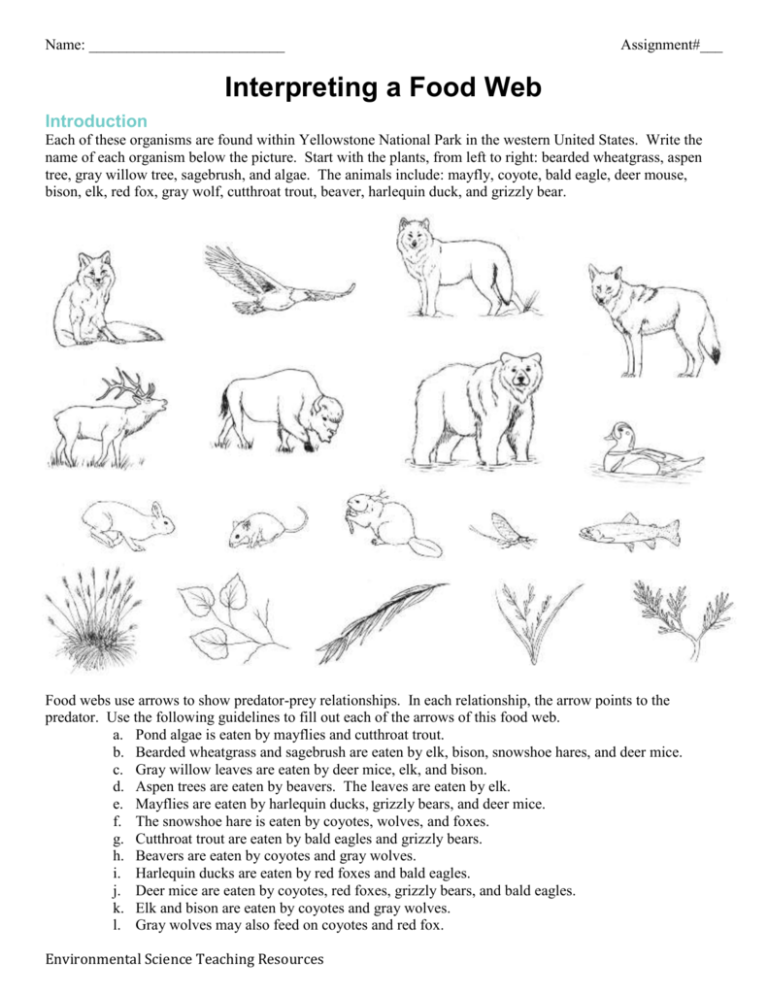
Name: __________________________ Assignment#___ Interpreting a Food Web Introduction Each of these organisms are found within Yellowstone National Park in the western United States. Write the name of each organism below the picture. Start with the plants, from left to right: bearded wheatgrass, aspen tree, gray willow tree, sagebrush, and algae. The animals include: mayfly, coyote, bald eagle, deer mouse, bison, elk, red fox, gray wolf, cutthroat trout, beaver, harlequin duck, and grizzly bear. Food webs use arrows to show predator-prey relationships. In each relationship, the arrow points to the predator. Use the following guidelines to fill out each of the arrows of this food web. a. Pond algae is eaten by mayflies and cutthroat trout. b. Bearded wheatgrass and sagebrush are eaten by elk, bison, snowshoe hares, and deer mice. c. Gray willow leaves are eaten by deer mice, elk, and bison. d. Aspen trees are eaten by beavers. The leaves are eaten by elk. e. Mayflies are eaten by harlequin ducks, grizzly bears, and deer mice. f. The snowshoe hare is eaten by coyotes, wolves, and foxes. g. Cutthroat trout are eaten by bald eagles and grizzly bears. h. Beavers are eaten by coyotes and gray wolves. i. Harlequin ducks are eaten by red foxes and bald eagles. j. Deer mice are eaten by coyotes, red foxes, grizzly bears, and bald eagles. k. Elk and bison are eaten by coyotes and gray wolves. l. Gray wolves may also feed on coyotes and red fox. Environmental Science Teaching Resources Analysis Questions 1. Why are the arrows always drawn from the prey towards the predators? What are they showing the flow of? 2. The four plants and algae at the bottom of your food web are the only organisms that do not have any arrows pointing at them. What is their source of energy? 3. Plants and algae are often referred to as producers. What exactly do they produce? 4. Primary consumers are organisms that directly feed on producers. What animals on your food web would be classified as primary consumers? 5. Secondary consumers are organisms that directly feed on primary consumers. What animals on your food web would be classified as secondary consumers? 6. Tertiary or top consumers are animals at the top of the food web. They may feed off either primary or secondary consumers. What animals would fit into this classification? 7. Primary consumers are sometimes called herbivores, as they only eat plants. Primary or secondary consumers that only eat meat are called carnivores. Primary or secondary consumers that eat both plants and animals are called omnivores. Identify the one omnivore in your food web. 8. If you were to take a walk through a part of Yellowstone National Park, which level of the food web would you expect to see the most of? a. Producers b. Primary consumers c. Secondary consumers d. Tertiary consumers 9. Which level of the food web would you expect to see the least of? Page 2 10. According to the Ten percent law, only about 10% of the energy consumed makes it from one trophic level to the next. With this in mind, if you started with 1000 calories of willow leaves, how many calories would make it to each of these other animals? a. Deer mouse: ________________ b. Red fox: ________________ c. Gray wolf: ________________ 11. Based on your answer to the previous question, why are there so many more producers in any given ecosystem than any other organism? Why are top predators so rare to witness in the wild? 12. One trophic level not shown on this food web is the decomposer. These organisms, which include bacteria, fungi, and some invertebrates, eat dead and decomposing organic matter. If you were to draw a decomposer on this food web, what arrows would be pointing to it? Further Discussion Watch this short video called “How Wolves Change Rivers” that shows the impact of the reintroduction of gray wolves to Yellowstone National Park back in 1995. Video link: https://www.youtube.com/watch?v=ysa5OBhXz-Q List the effects that the wolves had on the ecosystem. A keystone species is one that has a disproportionately large impact on its environment. Would you classify the wolves as a keystone species? Explain why or why not. Page 3
